It is not given to many for their surname to be turned into an adjective immediately recognisable by a section of society. ‘Fowlerised’ meant a house transformed by John Fowler to his (and the owners’) taste.
In spite of having known John for many years, I had little idea of the extent of his work and influence until I read this book. Dedicated to looking and learning, he dealt with all dates and styles of buildings through scholarship and his prodigious memory.
He was born in 1906, a one-off in his family with artistic talents that took him to painting furniture for Peter Jones in 1934, earning £4 a week. He was refused a rise in wages so he and his colleagues downed brushes and set up on their own.
They struggled on till 1938 when John joined Lady Colefax. Twice his age and a fashionable decorator with a shop in Mayfair, Sybil Colefax knew the women who wanted to do something more than Syrie Maugham’s everlasting white and mushroom, which had ruled during the early Thirties. Fashion had moved on in its inexorable way and John seized the opportunity.
Through his personality and knowledge he soon became the clients’ favourite. He was exempted from war service because of myopia. While fabrics were rationed he used his ingenuity to cover sofas with old curtains, and his clients’ unwanted evening dresses were cut up to make trimmings or cushion covers.
When Nancy Tree (later Lancaster) bought into the business now called Colefax & Fowler in 1944, she and John became an irresistible force. They bickered and sparred, they flounced out and flounced back, they laughed and got angry, and through this exhausting process produced some of the most beautiful interiors in the land.
They fed off each other to the benefit of their clients. The business prospered through word of mouth, friends and relations; the highest echelon of society aspired to this resourceful duo. Nancy (the subject of a brilliant biography by Martin Wood) had the ideas and taught John how the famous houses were to be lived in and enjoyed through comfort and beauty. John, the dictator of the workroom, got on and performed the task, supported by his skilled craftsmen. He taught them as Nancy had taught him.
Before John came on the scene the Trees had bought a James Gibbs house, Ditchley Park in Oxfordshire, and made it an earthly paradise. Ditchley was an inspiration to John. In 1954 Nancy (now married to Jubie Lancaster) restored Haseley Court, near Oxford, where their ‘full-blown’ taste reached its zenith.
The list of places John worked on reads like a dictionary of that unique English asset envied by the rest of the world — the country house. It included Blithfield Hall in Staffordshire, Radburne Hall near Derby, Mereworth Castle in Kent, Arundel Park and Syon House. Most were private houses, but some opened to the public after the war. The index shows hardly a county without an example of his work.
In 1956 John got his first job with the National Trust at magical Claydon House. This led to many more, including Sudbury Hall in Derbyshire. I was on the committee for its redecoration before the Trust opened it to the public. I carried John’s patterns, flew up and down stairs, moved furniture (‘Don’t push that chair — PICK IT UP’), and trudged the length of the Long Gallery time after time at his bidding. He was already mortally ill, but did not spare himself or his helpers in the unwelcoming, cold rooms which turned into fairyland under his direction. His treatment of the staircase there was an example of his disdain for democracy. The committee arrived one day to find the carved balusters had been painted white and the walls brilliant yellow. ‘Jaws dropped’ but the murmuring went unheeded and we went on to the next thing.
Cornbury Park and Chequers, two mammoth jobs, were his last major commissions. Neither is accessible to you and me, but both are mighty impressive according to the lucky few who know them.
John was two people. A tyrant to his staff, he changed into a delightful companion after work, amusing and amused. He took to gardening and saw the importance of the relationship between indoors and out. He was also a master of scale. The photographs of a ‘pocket’ flat, the size of a double garage, give the impression of a much bigger place. He dealt with palaces and cottages with equal enthusiasm.
This book is a historic document, a reminder of times past, a beautifully written work with photographs that accurately depict the interiors — even the colours are right. It will be the standard reference book of taste in England during the second half of the 20th century.






Comments